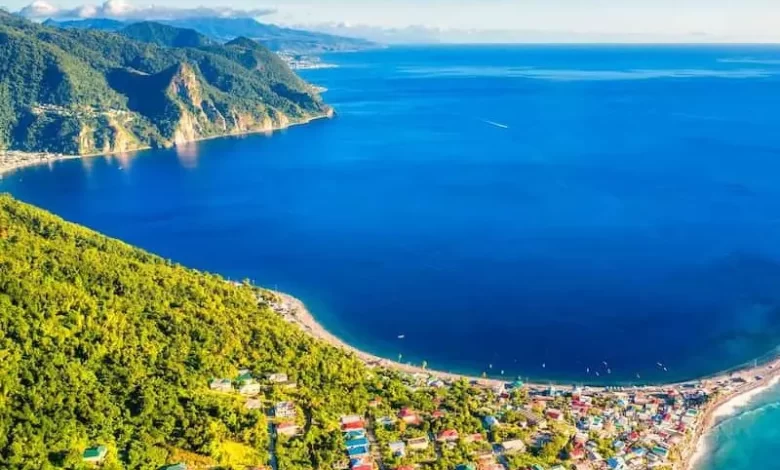Caribbean Sea, Dominica

The Caribbean Sea borders Dominica’s West Coast, while the Atlantic Ocean borders its East Coast. This positioning provides the island with numerous natural attractions, including pristine beaches, vibrant marine life, and significant ecological sites integral to the Island’s geography, culture, and economy.
Significance of the Caribbean Sea to Dominica
The Caribbean Sea greatly influences Dominica’s climate and weather patterns during Dominica’s Hurricane Season, with villages often facing severe weather conditions. The surrounding sea moderates temperatures, making the coastal areas cooler and more humid. The sea is also a vital source of rainfall, contributing to Dominica being one of the earth’s most rain-drenched lands, which supports its lush rainforests and diverse ecosystems.
Dominica’s Tourism Industry relies on the allure of the Caribbean Sea. The island’s west coast, stretching from Capuchin in Saint John Parish to Scotts Head in Saint Mark Parish, has attractions and facilities that draw visitors, like Cabrits National Park. Notable sites include the Roseau Cruise Ship Berth, which facilitates many tourist arrivals, and luxurious resorts like Secret Bay and Fort Young Hotel. The sea’s influence extends to the Edward Oliver Leblanc Highway, which meanders along its coast, providing scenic drives highlighting the island’s coastal beauty. Additionally, the proximity to the Caribbean Sea has facilitated the development of eco-friendly resorts and hotels, such as Secret Bay and Jungle Bay Resort, which overlook the Caribbean Sea and offer eco-conscious accommodations.
Beaches and Marine Life
The Caribbean Sea provides the island with beautiful beaches and rich marine reserves, such as the Salisbury Marine Reserve and Soufriere Scotts Head Marine Reserve. Champagne Reef is famous for its underwater geothermal vents that create a sparkling effect, making it a popular spot for snorkelling and scuba diving. Similarly, Scotts Head Beach, located at the southern tip of the island, offers a mix of volcanic and coral formations, providing excellent opportunities for underwater exploration. These beaches are part of the larger Soufrière Scottshead Marine Reserve, which protects the area’s diverse marine life and coral reefs.
Dominica’s location in the Caribbean Sea enhances its natural allure and is crucial to its environmental and economic sustainability. The island continues to attract visitors worldwide with its unspoiled landscapes, diverse marine life, and commitment to preserving its natural heritage.
Rivers Flowing into the Caribbean Sea
Several major rivers in Dominica, including the Layou River, Indian River, and Roseau River, flow directly into the Caribbean Sea. These rivers are crucial for maintaining the island’s lush landscapes and supporting agricultural and tourism industries. The Canefield Airport, located adjacent to the Caribbean Sea, also benefits from its proximity, facilitating convenient access for visitors.
The Caribbean Sea is vital to Dominica’s environment, economy, and way of life. Its influence spans from natural beauty and biodiversity to tourism and infrastructure, making it an indispensable part of the island’s identity and sustainability efforts.




